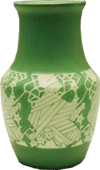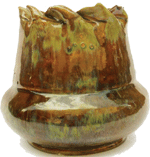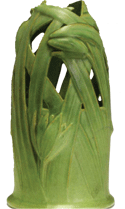|
Many Glazes and Shapes Defined Early American Art Pottery
By Anne Gilbert
Collector interest for
early American Art pottery
continues although auction
prices are for the most part
are under estimate. Good
pieces still come to market
so it is a good time to buy. As
in all collecting categories,
it is wise to know what is
a bargain and what isn’t. It
is important to recognize
the many types of glazes,
techniques and forms, as
well as important artisans.
Would you know a piece
of Mission ware or an atypical
example by “the mad potter”
George Ohr? In the case of
Ohr pottery, most familiar
are his grotesque head vases.
Less familiar forms can go
by unrecognized and be
worth more than $2,000.
While just about every
collector is familiar with
Rookwood, Roseville and
Grueby pottery, how about
Overbeck?
CLUES: When it comes
to form, most collectors
think of Teco pottery. It was
first introduced in 1902 by
William Gates. The name
came from “te” in terra and
“co” in cotta. His vases in
large sizes, and architectural
form, green glaze can
command $30,000 these
days.
Mission ware that
suggests Southwestern
skies and deserts was
actually created in Arkansas
in 1910, using naturallycolored
clays. The result
was a marbleized look. The
pottery works were named
“Niloak,” which backwards
spells “kaolin.” Kaolin was
used for centuries in the
Orient to make porcelain.
Newcomb pottery
was made in New Orleans
from 1899 to 1945. Early
pieces can be recognized by
incised designs. The glaze
was transparent and glossy.
Metallic luster glazes
turn up in Weller pottery
created by Jacques Sicard.
Prices can be over $2,000.
The effect is similar to
Tiffany Favrile glass.
However, the greatest
variety of glazes was created
by Rookwood pottery. Every
name describes the glaze. For
instance, “tiger eye,” created
in 1884, uses gold flecks
with a brown-orange glaze
that suggest the eye of a tiger.
Vellum, a matt glaze with
the look of old parchment,
took many years to develop.
It was introduced in 1904
at the St. Louis Exposition.
There are many art
pottery makers that you may never have heard of, but are
worth learning about. One
example is the Overbeck
pottery founded by four
sisters in Cambridge, Indiana.
They made pieces both on a
wheel and also commercially.
Their pieces have a stylized
monogram mark that
resembles a teapot with a
face or initials of the designer
or potter. When examples
come to auction, prices can
fetch more than $7,000.
Research American art
pottery in the many books on
the subject and go hunting.
|

Overbeck vase with
incised figures.

George Ohr vase,
waisted shape

Rare Teco vase,
matt glaze.
(All photos:
Toomey Galleries,
Oak Park, Ill.)
|